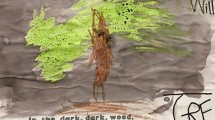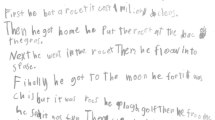Abstract
By the upper elementary grades, writing becomes an essential tool both for learning and for showing what you know. Students who struggle significantly with writing are at a terrible disadvantage. Data from the National Assessment of Educational Progress indicate that only 25% of students can be classified as competent writers; students with learning disabilities (LD) have even greater problems with writing than their normally achieving peers and frequently demonstrate a deteriorating attitude toward writing after the primary grades. In this article, we focus on composing and the writing process, and examine the knowledge base about writing development and instruction among students with LD. We address what research tells us about skilled writers and the development of writing knowledge, strategies, skill, and the will to write, and how this relates to students with LD. Next, we summarize what has been learned from research on writing development, effective instruction, and the writing abilities of students with LD in terms of effective instruction for these students. Finally, we indicate critical areas for future research.
Similar content being viewed by others
References
Applebee, A., & Langer, J. (2006). The state of writing instruction: What existing data tell us. Albany: Center on English Learning and Achievement.
Applebee, A., Langer, J., & Mullis, I. (1986). The writing report card: Writing achievement in American schools. Princeton: Educational Testing Service.
Applebee, A., Langer, J., Jenkins, L., Mullis, I., & Foertsch, M. (1990). Learning to write in our Nations’ schools. Princeton: Educational Testing Service.
Applebee, A., Langer, J., Mullis, I., Latham, A., & Gentile, C. (1994). NAEP 1992: Writing report card. Washington: US Government Printing Office.
ASCD (Producer) (2002). Teaching students with learning disabilities in the regular classroom: Using learning strategies. (DVD). http://shop.ascd.org/ProductDetail.aspx?ProductId=1553, Alexandria, VA: ASCD.
Baker, S. K., Chard, D. J., Ketterlin-Geller, L. R., Apichatabutra, C., & Doabler, C. (2009). Teaching writing to at-risk students: The quality of evidence for self-regulated strategy development. Exceptional Children, 75(3), 303–318.
Bereiter, C., & Scardamalia, M. (1987). The psychology of written composition. Hillsdale: Erlbaum.
Berman, J. (2001). Industry output and employment projections to 2010. Monthly Labor Review, 124, 39–56.
Berninger, V. W., Rutberg, J. E., Abbott, R. D., Garcia, N., Anderson-Youngstrom, M., Brooks, A., et al. (2006). Tier 1 and tier 2 early intervention for handwriting and composing. Journal of School Psychology, 44(1), 3–30.
Berninger, V. W., Nielson, K., Abbott, R., Wijsman, E., & Raskind, W. (2008). Writing problems in developmental dyslexia: Underrecognized and undertreated. Journal of School Psychology, 46(1), 1–21.
De La Paz, S. (2007). Best practices in teaching writing to students with special needs. In S. Graham, C. A. MacArthur, & J. Fitzgerald (Eds.), Best practices in writing instruction (pp. 308–328). New York: Guilford.
Englert, C. S., Raphael, T. E., Anderson, L., Anthony, H., Stevens, D., & Fear, K. (1991). Making writing strategies and self-talk visible: Cognitive strategy instruction in writing in regular and special education classrooms. American Educational Research Journal, 28, 337–373.
Graham, S. (2006). Writing. In P. Alexander & P. Winne (Eds.), Handbook of educational psychology (pp. 457–478). Mahwah: Erlbaum.
Graham, S. (2010). Teaching writing. P. Hogan (Ed.), Cambridge encyclopedia of language Sciences (pp. 848–851). Cambridge University Press, Cambridge, UK.
Graham, S., & Harris, K. R. (1994). The effects of whole language on children’s writing: A review of literature. Educational Psychologist, 29, 187–192.
Graham, S., & Harris, K. R. (1996). Addressing problems in attention, memory, and executive functioning: An example from self-regulated strategy development. In G. Reid Lyon & N. A. Krasnegor (Eds.), Attention, memory, and executive function (pp. 349–366). Baltimore: Brookes.
Graham, S., & Harris, K. R. (2002). Prevention and intervention for struggling writers. In M. Shinn, G. Stoner, & H. Walker (Eds.), Interventions for academic and behavior problems II: Preventive and remedial approaches (pp. 589–610). Bethesda: National Association of School Psychologists.
Graham, S., & Harris, K. R. (2005a). Writing better: Effective strategies for teaching students with learning difficulties. Baltimore: Brookes.
Graham, S., & Harris, K. R. (2005b). Improving the writing performance of young struggling writers: Theoretical and programmatic research from the Center to Accelerate Student Learning. Journal of Special Education, 39(1), 19–33.
Graham, S., & Harris, K. R. (2009a). Almost 30 years of writing research: Making sense of it all with The Wrath of Khan. Learning Disabilities Research and Practice, 24, 58–68.
Graham, S., & Harris, K. R. (2009b). Evidence-based writing practices: Drawing recommendations from multiple sources. British Journal of Educational Psychology (monograph series), 6, 95–111.
Graham, S., & Harris, K. R. (2011). Writing and students with disabilities. In L. Lloyd, J. Kauffman, & D. Hallahan (Eds.). Handbook of special education (pp. 422–433). London, UK: Routledge.
Graham, S., & Hebert, M. (2010). Writing to read: Evidence for how writing can improve reading. Alliance for Excellence in Education, Washington, DC (commissioned by the Carnegie Corp. of New York).
Graham, S., & Perin, D. (2007a). A meta-analysis of writing instruction for adolescent students. Journal of Educational Psychology, 99, 445–476.
Graham, S., & Perin, D. (2007b). Writing next: Effective strategies to improve writing of adolescent middle and high school. Alliance for Excellence in Education, Washington, DC (commissioned by the Carnegie Corp. of New York).
Graham, S., Harris, K. R., & MacArthur, C. (2004). Writing instruction. In B. Wong (Ed.), Learning about learning disabilities (3rd ed., pp. 281–313). Orlando: Academic.
Graham, S., Harris, K. R., & Olinghouse, N. (2007). Addressing executive function problems in writing. In L. Meltzer (Ed.), Executive function in education: From theory to practice (pp. 216–236). New York: Guilford.
Graham, S., MacArthur, C., & Fitzgerald, J. (2007). Best practices in writing instruction. NY: Guilford.
Harris, K. R. (1982). Cognitive-behavior modification: Application with exceptional students. Focus on Exceptional Children, 15(2), 1–16.
Harris, K. R. (1986). The effects of cognitive-behavior modification on private speech and task performance during problem solving among learning disabled and normally achieving children. Journal of Abnormal Child Psychology, 14, 63–76.
Harris, K. R., & Graham, S. (1985). Improving learning disabled students’ composition skills: Self-control strategy training. Learning Disability Quarterly, 8, 27–36.
Harris, K. R., & Graham, S. (1992). Self-regulated strategy development: A part of the writing process. In M. Pressley, K. R. Harris, & J. T. Guthrie (Eds.), Promoting academic competence and literacy in school (pp. 277–309). New York: Academic.
Harris, K. R., & Graham, S. (1994). Constructivism: Principles, paradigms, and integration. The Journal of Special Education, 28, 233–247.
Harris, K. R., & Graham, S. (1996). Making the writing process work: Strategies for composition and self-regulation (2nd ed.). Cambridge: Brookline Books.
Harris, K. R., & Graham, S. (1999). Programmatic intervention research: Illustrations from the evolution of self-regulated strategy development. Learning Disability Quarterly, 22, 251–262.
Harris, K. R., & Graham, S. (2009). Self-regulated strategy development in writing: Premises, evolution, and the future. British Journal of Educational Psychology (monograph series), 6, 113–135.
Harris, K.R., & Pressley, M. (1991). The nature of cognitive strategy instruction: Interactive strategy construction. Exceptional Children, 57, 392–405.
Harris, K. R., Graham, S., & Mason, L. (2003). Self-regulated strategy development in the classroom: Part of a balanced approach to writing instruction for students with disabilities. Focus on Exceptional Children, 35(7), 1–16.
Harris, K. R., Graham, S., Mason, L., & Friedlander, B. (2008). Powerful writing strategies for all students. Baltimore: Brookes.
Harris, K. R., Graham, S., Brindle, M., & Sandmel, K. (2009). Metacognition and children’s writing. In D. Hacker, J. Dunlosky, & A. Graesser (Eds.), Handbook of metacognition in education (pp. 131–153). Mahwah: Erlbaum.
Harris, K.R., Graham, S., MacArthur, C., Reid, R., & Mason, L. (2011). Self-regulated learning processes and children’s writing. B. Zimmerman and D.H. Schunk (Eds.), Handbook of self-regulation of learning and performance (pp. 187–202). Routledge Publishers.
Hayes, J. (1996). A new framework for understanding cognition and affect in writing. In M. Levy & S. Ransdell (Eds.), The science of writing: Theories, methods, individual differences, and applications (pp. 1–27). Mahwah: Erbaum.
Hayes, J., & Flower, L. (1980). Identifying the organization of writing processes. In L. Gregg & E. Steinberg (Eds.), Cognitive processes in writing (pp. 3–30). Hillsdale: Erlbaum.
Kirsch, I., Braun, H., Yamamoto, K., & Sum, A. (2007). America’s perfect storm: Three forces changing our Nation’s future. Princeton: ETS.
Lane, K., Harris, K. R., Graham, S., Weisenbach, J., Brindle, M., & Morphy, P. (2008). The effects of self-regulated strategy development on the writing performance of second grade students with behavioral and writing difficulties. Journal of Special Education, 41, 234–253.
MacArthur, C. A., Graham, S., & Fitzgerald, J. (Eds.). (2006). Handbook of writing research. New York: Guilford.
Mason, L. H. (2004). Explicit self-regulated strategy development versus reciprocal questioning: Effects on expository reading comprehension among struggling readers. Journal of Educational Psychology, 96, 283–296.
Mason, L. H., Hickey Snyder, K., Sukhram, D. P., & Kedem, Y. (2006). Self-regulated strategy development for expository reading comprehension and informative writing: Effects for nine 4th-grade students who struggle with learning. Exceptional Children, 73, 69–89.
National Commission on Writing (2003). The neglected “R.” College Entrance Examination Board.
Olinghouse, N., Graham, S., & Harris, K. R. (2010). Evidence-based writing practices at the primary and secondary/tertiary level. In M. Shinn, H. Walker, & G. Stoner (Eds.), Interventions for achievement and behavior in a three-tier model including RTI (pp. 553–570). Washington, DC: National Association of School Psychologists.
Persky, H., Daane, M., & Jin, Y. (2003). National assessment of educational progress: 2002 report card for the nation and the states. Washington, DC: US Department of Education.
Reid, R., & Lienenmann, T. O. (2006). Strategy instruction for students with learning disabilities. New York: Guilford.
Rogers, L., & Graham, S. (2008). A meta-analysis of single subject design writing intervention research. Journal of Educational Psychology, 100, 879–906.
Salahu-Din, D., Persky, H., & Miller, J. (2008). The Nation’s Report Card: Writing 2007 (NCES 2008-468). Washington, DC: National Center for Education Statistics, Institute of Education Sciences, U.S. Department of Education.
Sandmel, K. N., Brindle, M., Harris, K. R., Lane, K. L., Graham, S., Nackel, J., et al. (2009). Making it work: Differentiating tier two self-regulated strategies development in writing in tandem with schoolwide positive behavioral support. Teaching Exceptional Children, 42(2), 22–35.
Scardamalia, M., & Bereiter, C. (1987). Knowledge telling and knowledge transforming in written compositions. In S. Rosenberg (Ed.), Advances in applied psycholinguistics (pp. 143–175). Cambridge, UK: Cambridge University Press.
Smyth, J. (1998). Written emotional expression: Effect sizes, out-come types, and moderating variables. Journal of Consulting and Clinical Psychology, 66, 174–184.
Swanson, H. L., & Berninger, V. W. (1996). Individual differences in children’s writing: A function of working memory or reading or both processes? Reading and Writing: An Interdisciplinary Journal, 8, 357–383.
Swedlow, J. (1999). The power of writing. National Geographic, 196, 110–132.
Troia, G. A. (2006). Writing instruction for students with learning disabilities. In C. A. MacArthur, S. Graham, & J. Fitzgerald (Eds.), Handbook of writing research (pp. 324–354). New York: Guilford.
Zimmerman, B., & Reisemberg, R. (1997). Becoming a self-regulated writer: A social cognitive perspective. Contemporary Educational Psychology, 22, 73–101.
Author information
Authors and Affiliations
Corresponding author
Rights and permissions
About this article
Cite this article
Harris, K.R., Graham, S. “An adjective is a word hanging down from a noun”: Learning to write and students with learning disabilities. Ann. of Dyslexia 63, 65–79 (2013). https://doi.org/10.1007/s11881-011-0057-x
Received:
Accepted:
Published:
Issue Date:
DOI: https://doi.org/10.1007/s11881-011-0057-x




